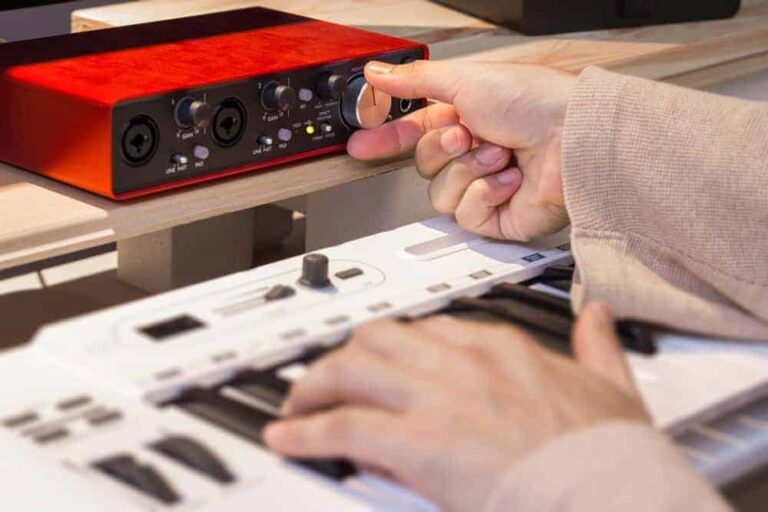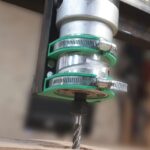You’ll see this thing pop up in every home studio set-up video. You can also find them in lists of important things to get for music production.
But are they really necessary? Can’t I record using my phone or the sound card on my computer?
Yes
The simple answer is yes. Audio interfaces function as sound cards with more capabilities compared to ones found in your computer.
They may look like an additional cost for your music production journey, but rest assured, you will find out why they are important.
What Is An Audio Interface?
For those of you unfamiliar, an audio interface is a rectangular-shaped (most of the time) box that allows you to connect instruments and microphones for recording.
Then they connect to your computer via USB. You can also plug in studio monitors and headphones for the mixing and mastering process in music production.
These devices are common in many professional and home studios and, as mentioned earlier, are recommended as an essential tool for music production.
If you want to produce music, here are some reasons why you will need this device.
Instrument Connectivity
You are going to have instruments and microphones around your room. That will require a lot of connections.
Your computer does not have enough places to connect your instruments. Not to mention, most of them are limited to USB connection.
Audio interfaces allow you to connect all your instruments and microphones to them while the interface connects to the computer. It will only need one USB port.
As for the type of connections audio interfaces have, they all come in both XLR and Quarter Jack connectors. Instruments like guitars and basses connect via a quarter jack.
As for microphones, they are connected via XLR. While you can use a USB microphone, the ones known for recording have an XLR connection.
Built For Music Production
Audio interfaces are made for music production. They are designed to record instruments or audio and transfer them into the computer while keeping the quality intact.
Recording directly through your computer will compromise the audio quality. The capabilities of the computer’s sound card are not built to produce the same level of quality compared to that of an audio interface.
They are also built to have more inputs and outputs, and phantom power for your microphone.
Monitoring
Another feature audio interfaces allow you to do is monitor either through headphones or studio monitors.
Using your computer’s built-in speaker is not a good idea, especially when mixing and mastering.
In this stage, it is important that you hear every sound at every frequency.
There might be certain frequencies that your computer cannot pick up or show clearly. This can lead you to miss out on details in the mix that might need editing.
Another thing you will need in music production is unbiased monitors. The speakers found in computers are built for commercial use. Like sound cards, their speakers aren’t built for music production.
With an audio interface, you can plug in your headphones designed for mixing and mastering audio. You can also plug in your studio monitors. These are unbiased speakers that read all frequencies.
Latency
Latency plays a big part in the quality of the recording.
Latency refers to the delay in time it takes for data to travel from the starting point to its destination. In the context of music production, the data refers to the audio recording.
Audio signals are converted into digital data that the computer can process and present to the Digital Audio Workstation (DAW).
The travel time for the signal to reach the destination takes time, which is why there will be some sort of delay that will occur.
The goal is to have little latency so that the travel time is close to real-time.
A noticeable delay in your recording session can throw you off from playing your instrument or singing. At worst, it will be impossible to have a smooth recording session.
For that to happen, you’ll have to configure some things. You’ll have to check if your computer’s CPU can handle the audio signal to digital data process and travel.
Even by tweaking it, you will still have some latency issues if you record directly into the computer’s sound card.
Luckily, most audio interfaces have what is called “direct monitoring.” Because you can plug in your headphones and studio monitors, it essentially bypasses the computer.
Even if the travel time is the same, you can still hear what you are recording while recording it. All of this is happening with zero latency.
Pre-Amps
Audio interfaces also come with pre-amps.
These are what allow low-level signals to reach line level.
Think of line level as the industry standard for how loud an audio signal should be in the mix and master. When you record signals using lower quality sound cards, the quality gets affected.
One such quality is the sound level. Even if you play your instrument loudly or sing to your heart’s content, it might still not be completely audible.
With the help of pre-amps, you can play regularly and still get that needed boost in audio level without the chances of the signal peaking.
Which Ones Should I Go For?
Okay, so you’re convinced of its importance. But you still might be hesitant to get one.
There are a lot of interfaces out there and all with different sizes. Do I have to get expensive ones?
Luckily there are budget-friendly options available. It is also recommended to start out with these if you are new to music production.
These audio interfaces have about two inputs and outputs, one monitor knob, a headphone knob, and two connectors for your studio monitors.
But even if you are more experienced or just have a regular home studio set-up, these types of interfaces will still suffice.
Frequently Asked Questions
Can I Still Get Good Results With My Computer Sound Card?
You can still get results for sure. However, if you mix and master your own music, you will need an audio interface.
Audio interfaces provide direct monitoring and allow you to connect studio monitors. These help you hear all of the things recorded in all frequencies.
What If I Want To Record Vocals Only? Do I Still Need An Audio Interface If I Have A USB Mic?
USB microphones are typically used for recording podcasts or live streaming set-ups. You can still record vocals with a USB microphone for rough demos.
But it is still recommended to use a condenser microphone for recording vocals. Since they have an XLR connection, you will need an audio interface.
How About Separate Sound Cards For Recording Music?
There are separate sound cards that allow you to do the same thing as an audio interface.
But in terms of quality, audio interfaces provide better quality.
As mentioned, budget-friendly audio interfaces still provide great value to your music production. So you don’t have to worry about spending a large amount of money on an important device.
Conclusion
Audio interfaces are important because they bridge your ideas into the place where you work on them (the DAW).
You need your music equipment to be of good quality, so that your future songs can also be of good quality.


